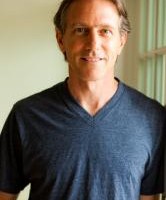Yoga is missing from teaching yoga.
While training people to teach yoga, I began thinking about that elusive quality, genius, where any endeavor feels inspired and effortless.
For many years my colleagues Stacy Dockins, Debbie Williamson and I were involved in yoga teacher trainings large and small. These trainings helped thousands of people in many ways, but they fell short in a single area: teaching teachers to teach yoga. And isn’t that the point of a teacher training, to learn to teach?
We finally confessed to each other what we didn’t want to say out loud: We had been part of a pretty massive failure. Our methods resulted in almost zero genius. Instead, we had trained teachers to become frozen, scared and scripted.
Instead of yoga teachers we were producing teachers who were acting like yoga teachers, and pretty badly at that.
Some sounded like kindergarten teachers. They would lead the class as though their students were somehow mentally and physically inadequate, unable to sit or even lay down without their precise step-by-step instructions every time. Some copied every word and intonation of their own teachers. Some were so nervous that they couldn’t look at their class. They appeared to be on life support.
Why was this happening? What was it about our methods that did not work?
We had created a learning environment that produced a persistent fear in the teachers. (I will share more of where this fear comes from in the next post.) And so, when talking to and coaching these teachers, we found that many were disappointed in their teaching experience.
Many had never inspired much of a following, and this led to a subtle kind of spiritual bankruptcy—a confirmation ”I’m not good enough. I’m failing. Spiritually I’m depleted.”
Some had gained a following but, unwilling to risk any changes, were not only stuck and uninspired, but exhausted from repeating their act.
Regardless of their following, these teachers knew they were not effective in the way they had dreamed they could be. Most of those we talked to knew something was wrong, especially in light of all that yoga practice had given them. How could this thing I love, yoga, turn into a job, a chore?
“How could I possibly dread teaching this?” they would finally ask.
We could have blamed Yoga Alliance for its out-of-balance certification standards. We could have blamed our own teachers, or the endless yoga schools who turn out thousands of petrified students every year. But we didn’t.
Instead, we reinvented yoga teacher training with the priority of coaxing out the inherent genius in each teacher.
The three of us tossed out the standard-issue teacher training curriculum. We studied the fastest and longest lasting learning methods through all disciplines. And we studied spirituality and yoga to find clues on how to reliably attain that deeply-relaxed yet highly-alert state through which our highest teaching flows. We continue to study.
We ask, “What if you could practice yoga while actually standing and teaching it?”
Because this is what is missing. Yoga is missing from teaching yoga.
The majority of teachers were not practicing yoga while teaching it. Quite the opposite. They were practicing a whole range of other strategies, from pedantically protecting themselves from embarrassment, to subtle attempts to manipulate their class to like or love them. As such, they were teaching fear.
When my colleagues and I compared notes we realized, dimly at first, that genius resides in each of us. When fear is absent, we automatically experience genius. It rushes in. A Course in Miracles says, “A cloud does not put out the sun.” We have seen genius rush in enough times now to be sure it is our natural state. My guess, it has been waiting since time began for these precious moments when we stop valuing fear.
We also recognize that we cannot teach it. Genius cannot be taught.
But we did discover how to create a practice-teaching environment where fear can safely be put aside and where people can discover genius in themselves. Where they can feel it and live in it long enough that it might not feel foreign any more.
We developed methods through which this elusive state might become more natural; the old way might become uncomfortable; this state of genius might even become a new way of living.
We train yoga teachers, but this journey belongs to everyone.
Our methods can benefit all teachers, performers, scientists, artists, anyone who communicates—everyone who wants access to the genius within.
The process is a little scary, because the first step is leaving the comfort of the known. It’s always a movement from certainty to uncertainty, from known to unknown. From defensiveness to defenselessness. From what seems like safety to what appears dangerous.
As any student of yoga knows, it’s well worth the risk.
___
Adapted from Philip Urso’s forthcoming book
~
Editor: Kate Bartolotta
 Share on bsky
Share on bsky





Read 28 comments and reply